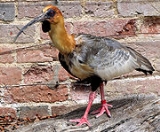
Theristicus
Encyclopedia
Theristicus is a genus of bird
s in the Threskiornithidae
family. They are found in open, grassy habitats in South America
. All have a long, decurved dark bill
, relatively short reddish legs that do no extend beyond the tail in flight (unlike e.g. Eudocimus
and Plegadis
), and at least the back is grey.
, but today all major authorities accept the split
. Furthermore, it has recently been suggested that the taxon
branickii should be considered a species, but at present most authorities maintain it as a subspecies of T. melanops.
Bird
Birds are feathered, winged, bipedal, endothermic , egg-laying, vertebrate animals. Around 10,000 living species and 188 families makes them the most speciose class of tetrapod vertebrates. They inhabit ecosystems across the globe, from the Arctic to the Antarctic. Extant birds range in size from...
s in the Threskiornithidae
Threskiornithidae
The family Threskiornithidae includes 34 species of large terrestrial and wading birds, falling into two subfamilies, the ibises and the spoonbills. It was formerly known as Plataleidae. The spoonbills and ibises were once thought to be related to other groups of long-legged wading birds in the...
family. They are found in open, grassy habitats in South America
South America
South America is a continent situated in the Western Hemisphere, mostly in the Southern Hemisphere, with a relatively small portion in the Northern Hemisphere. The continent is also considered a subcontinent of the Americas. It is bordered on the west by the Pacific Ocean and on the north and east...
. All have a long, decurved dark bill
Beak
The beak, bill or rostrum is an external anatomical structure of birds which is used for eating and for grooming, manipulating objects, killing prey, fighting, probing for food, courtship and feeding young...
, relatively short reddish legs that do no extend beyond the tail in flight (unlike e.g. Eudocimus
Eudocimus
Eudocimus is a genus of ibises, wading birds of the family Threskiornithidae. They occur in the warmer parts of the New World with representatives from the southern United States south through Central America, the West Indies and South America....
and Plegadis
Plegadis
Plegadis is a bird genus in the family Threskiornithidae. Member species are found on every continent except Antarctica as well as a number of islands. The Glossy Ibis is easily the most widespread of the three species...
), and at least the back is grey.
Taxonomy
Formerly, T. caudatus included T. melanopis as a subspeciesSubspecies
Subspecies in biological classification, is either a taxonomic rank subordinate to species, ora taxonomic unit in that rank . A subspecies cannot be recognized in isolation: a species will either be recognized as having no subspecies at all or two or more, never just one...
, but today all major authorities accept the split
Lumpers and splitters
Lumping and splitting refers to a well-known problem in any discipline which has to place individual examples into rigorously defined categories. The lumper/splitter problem occurs when there is the need to create classifications and assign examples to them, for example schools of literature,...
. Furthermore, it has recently been suggested that the taxon
Taxon
|thumb|270px|[[African elephants]] form a widely-accepted taxon, the [[genus]] LoxodontaA taxon is a group of organisms, which a taxonomist adjudges to be a unit. Usually a taxon is given a name and a rank, although neither is a requirement...
branickii should be considered a species, but at present most authorities maintain it as a subspecies of T. melanops.
- Plumbeous IbisPlumbeous IbisThe Plumbeous Ibis is a species of bird in the Threskiornithidae family. It is found in grassland, savanna, fields and marshes in central South America, ranging in south-central and south-eastern Brazil, eastern and northern Bolivia, Paraguay, Uruguay and northern Argentina...
, Theristicus caerulescens. - Buff-necked IbisBuff-necked IbisThe Buff-necked Ibis , also known as the White-throated Ibis, is a fairly large ibis found widely in open habitats of eastern and northern South America...
, Theristicus caudatus. - Black-faced IbisBlack-faced IbisThe Black-faced Ibis is a species of bird in the Threskiornithidae family. It is found in grassland and fields in southern and western South America. It has been included as a subspecies of the similar Buff-necked Ibis, but today all major authorities accept the split...
, Theristicus melanopis.- Andean Ibis, Theristicus (melanopis) branickii.

